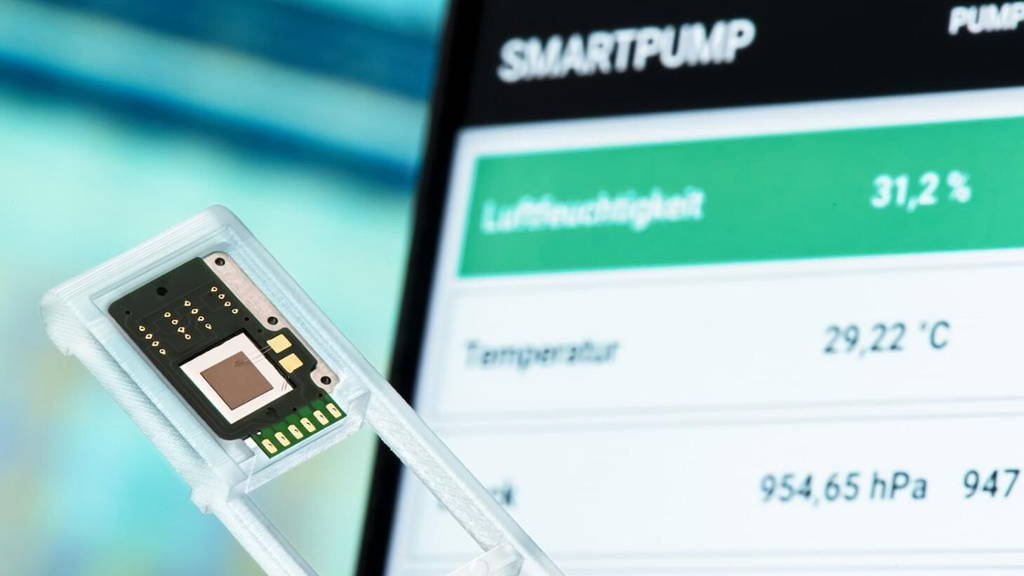“Our smart pump measures only 25 square millimeters, making it the world’s smallest pump. That said, it still has a high compression ratio,” says Dr. Martin Richter, department head of micro dosing systems at the Fraunhofer Research Institution for Microsystems and Solid State Technologies EMFT in Munich.
Richter and his team use the piezoelectric effect, which converts an applied electrical field into mechanical strain, to generate pressure in the pump chamber. Alternating the voltage helps move the silicon membrane up or down, which in turn draws in ambient air through a valve and compresses it in the pump chamber before expelling it.
As part of Fraunhofer’s Discover funding program, which supports unconventional and original ideas, Richter and his team is also looking into an additional application: adding scent information to audio and video files. “A headset fitted with our smart pump could deliver precise doses of different scents close to the nose. The gaming industry has already expressed an interest in this.” Richter adds that the smart pump should be an interesting prospect for anyone looking to deliver precise, tiny doses of liquids or gases.
The smart pump project is being funded by the Fraunhofer Future Foundation, which aims to strengthen innovation and employment in Germany by licensing research results to companies.
Richter and his team came up with a trick to reduce this dead volume and increase the pump’s suction capacity. “We use the piezo effect to specifically preload the diaphragm when assembling the piezoceramic. The advantage of this is that we no longer need a deep pump chamber. This trick enables us not only to build micropumps with high compression ratios but also to make them smaller in size.”
Not just the diaphragm but also the flap valves and the pump chamber are made of monocrystalline silicon, which offers numerous benefits over metals and plastics. For one, the metalloid – which is also used to make solar cells and computer chips – is pliable and fatigue-free. For another, the individual pump components can be etched from the silicon layer with a high degree of precision and subsequently joined together.
However, its disadvantage is the relatively high cost of silicon, which is why it is crucial to make the pump as small as possible. “Our goal is to reduce the size of the pump to 10 square millimeters to make its mass production profitable. We are well on track to achieving this,” Richter says.
Richter and his team use the piezoelectric effect, which converts an applied electrical field into mechanical strain, to generate pressure in the pump chamber. Alternating the voltage helps move the silicon membrane up or down, which in turn draws in ambient air through a valve and compresses it in the pump chamber before expelling it.
Multiple applications
The micropump could also be used in medicine, for instance as a medical patch to continuously deliver tiny amounts of hormone or pain killer. Or as an implant to help regulate pressure within the eye in treating glaucoma. The pump could also supply machines with precise doses of lubricant. “This is an application that we are currently developing with a partner from industry.”As part of Fraunhofer’s Discover funding program, which supports unconventional and original ideas, Richter and his team is also looking into an additional application: adding scent information to audio and video files. “A headset fitted with our smart pump could deliver precise doses of different scents close to the nose. The gaming industry has already expressed an interest in this.” Richter adds that the smart pump should be an interesting prospect for anyone looking to deliver precise, tiny doses of liquids or gases.
The smart pump project is being funded by the Fraunhofer Future Foundation, which aims to strengthen innovation and employment in Germany by licensing research results to companies.
Using tricks to increase pressure
Conventional micro diaphragm pumps powered by piezoelectricity generate only relatively low pressure with air; the asymmetry of the piezo effect means a lot of room is required in the pump chamber to move the membrane. This inevitably results in a high dead volume, in other words a high volume of residual gas within the chamber.Richter and his team came up with a trick to reduce this dead volume and increase the pump’s suction capacity. “We use the piezo effect to specifically preload the diaphragm when assembling the piezoceramic. The advantage of this is that we no longer need a deep pump chamber. This trick enables us not only to build micropumps with high compression ratios but also to make them smaller in size.”
Not just the diaphragm but also the flap valves and the pump chamber are made of monocrystalline silicon, which offers numerous benefits over metals and plastics. For one, the metalloid – which is also used to make solar cells and computer chips – is pliable and fatigue-free. For another, the individual pump components can be etched from the silicon layer with a high degree of precision and subsequently joined together.
However, its disadvantage is the relatively high cost of silicon, which is why it is crucial to make the pump as small as possible. “Our goal is to reduce the size of the pump to 10 square millimeters to make its mass production profitable. We are well on track to achieving this,” Richter says.






